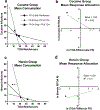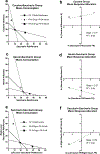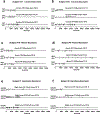Cocaine and heroin interact differently with nondrug reinforcers in a choice situation
- PMID: 37535523
- PMCID: PMC10837314
- DOI: 10.1037/pha0000674
Cocaine and heroin interact differently with nondrug reinforcers in a choice situation
Abstract
The present study used a rat choice model to test how cocaine or heroin economically interacted with two different nondrug reinforcers along the substitute-to-complement continuum. In Experiment 1, the nondrug alternative was the negative reinforcer timeout-from-avoidance (TOA)-that is, rats could press a lever to obtain a period of safety from footshock. One group of rats chose between cocaine and TOA and another group chose between heroin and TOA. The relative prices of the reinforcers were manipulated across phases while controlling for potential income effects. When cocaine was the reinforcer, rats reacted to price changes by increasing their allocation of behavior to the more expensive option, thereby maintaining relatively proportional intake of cocaine and TOA reinforcers across prices, suggesting these reinforcers were complements here. In contrast, when heroin became relatively cheap, rats increased allocation of income to heroin and decreased allocation of income to TOA, suggesting that heroin substituted for safety. Additionally, rats were willing to accept more footshocks when heroin was easily available. In Experiment 2, the nondrug alternative was saccharin, a positive reinforcer. Heroin and saccharin were complements, but there was no consistent effect of price changes on the allocation of behavior between cocaine and saccharin. As a model of the processes that could be involved in human drug use, these results show that drug-taking behavior depends on the type of drug, the type of nondrug alternative available, and the prices of both. (PsycInfo Database Record (c) 2024 APA, all rights reserved).
Figures








Similar articles
-
A Review of Behavioral Economic Manipulations Affecting Drug versus Nondrug Choice in Rats.Perspect Behav Sci. 2025 Apr 7;48(2):341-366. doi: 10.1007/s40614-025-00445-5. eCollection 2025 Jun. Perspect Behav Sci. 2025. PMID: 40520583 Free PMC article. Review.
-
An investigation of economic interactions between social reinforcement and heroin or cocaine in rats.Behav Pharmacol. 2024 Dec 1;35(8):442-452. doi: 10.1097/FBP.0000000000000798. Epub 2024 Oct 15. Behav Pharmacol. 2024. PMID: 39421898
-
The effect of economy type on heroin and saccharin essential value.Exp Clin Psychopharmacol. 2019 Dec;27(6):598-608. doi: 10.1037/pha0000277. Epub 2019 Mar 21. Exp Clin Psychopharmacol. 2019. PMID: 30896241 Free PMC article.
-
Extended heroin access increases heroin choices over a potent nondrug alternative.Neuropsychopharmacology. 2013 Jun;38(7):1209-20. doi: 10.1038/npp.2013.17. Epub 2013 Jan 15. Neuropsychopharmacology. 2013. PMID: 23322185 Free PMC article.
-
Neurobiology of relapse to heroin and cocaine seeking: a review.Pharmacol Rev. 2002 Mar;54(1):1-42. doi: 10.1124/pr.54.1.1. Pharmacol Rev. 2002. PMID: 11870259 Review.
Cited by
-
A Review of Behavioral Economic Manipulations Affecting Drug versus Nondrug Choice in Rats.Perspect Behav Sci. 2025 Apr 7;48(2):341-366. doi: 10.1007/s40614-025-00445-5. eCollection 2025 Jun. Perspect Behav Sci. 2025. PMID: 40520583 Free PMC article. Review.
-
Mechanistic and translational insights from preclinical cocaine choice procedures on the economic substitutability of cocaine and nondrug reinforcers.Neurosci Biobehav Rev. 2025 Aug;175:106217. doi: 10.1016/j.neubiorev.2025.106217. Epub 2025 May 21. Neurosci Biobehav Rev. 2025. PMID: 40409443 Review.
-
Effects of pharmacological and environmental manipulations on choice between fentanyl and shock avoidance/escape in male and female rats under mutually exclusive and non-exclusive choice conditions.Neuropsychopharmacology. 2024 Dec;49(13):2011-2021. doi: 10.1038/s41386-024-01939-7. Epub 2024 Aug 5. Neuropsychopharmacology. 2024. PMID: 39103498 Free PMC article.
-
An investigation of economic interactions between social reinforcement and heroin or cocaine in rats.Behav Pharmacol. 2024 Dec 1;35(8):442-452. doi: 10.1097/FBP.0000000000000798. Epub 2024 Oct 15. Behav Pharmacol. 2024. PMID: 39421898
References
-
- Ahmed SH (2010). Validation crisis in animal models of drug addiction: beyond non-disordered drug use toward drug addiction. Neuroscience & Biobehavioral Reviews, 35, 172–184. - PubMed
-
- Allison J (1983). Behavioral Economics. New York: Praeger.
MeSH terms
Substances
Grants and funding
LinkOut - more resources
Full Text Sources
Research Materials

